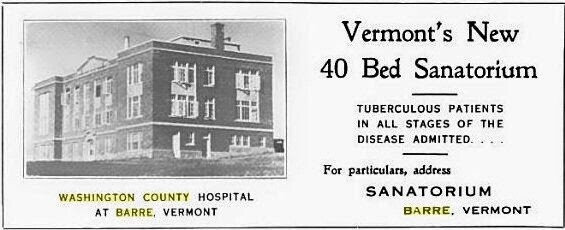VT Department of Health - History and Environmental Health

Vermont Department of Health - History
Vermont’s Department of Health originated in 1886 as the State Board of Health, one of the first public health organizations in the country. In its 137 years, it strove to improve the well-being of Vermonters by responding to and trying to prevent diseases caused by unsafe water, food supplies and contagion. Tuberculosis was virulent in 1907, for example, with 463 deaths from the disease. The reported average life expectancy was 48.4 years in 1913. The main treatment for tuberculosis was rest, where the afflicted would spend months or years in sanitoriums. It would be 46 years before an effective treatment – the drug, isoniazid – would end that practice and help to control the disease.
Other public health crises marked the history of the Health Department – the nation’s first statewide epidemic of infantile paralysis occurred in Vermont in 1914 and, during the same period, there had been severe epidemics of flu and measles. Federal research on diseases caused by dust looked at silicosis – disease of the lungs similar to black lung – in Vermont granite workers. 1937 brought a new silicosis control program from the Health Department that instituted “new dust control measures, inspection procedures and annual chest x-rays of workers.”
Environment and Health
For our first look into current programs and resources of the Vermont Department of Health (VDH), we focus on Health and the Environment, which includes everything from Bed Bugs to Lead Poisoning to Weather Related Health Concerns. VDH has a wide range of services and information about this broad category of public health. Vermont 211 includes several key programs in its database, listed with the keywords below to search our Community Resource Directory online (https://navigateresources.net/211vermont/)
- Bed Bug Information
- Health Related Extreme Weather Information (much of which is the result of climate change)
- Extreme Heat Cooling Programs (Look for Maps)
- Public Awareness/Education (Look for tags of Climate Change Prevention Programs, Cold Weather Advisories, and Extreme Heat Advisories/Warnings)
- Lead and Asbestos Information for Property Owners
- Asbestos Information
- Lead Information (and look for the tag, Parents, for information for parents)
- Lead Poisoning Prevention Program
- Landlord Rights Information/Counseling (Look for the tag, Lead Information)
- Lead Information (and look for the tags, Homeowners and Landlords)
- Lead Testing
- Mold and Mildew in Homes
- Rabies Information
- Rabies Control
- Specialized Information and Referral (Look for Rabies)
- Radon Information and Testing
- Tick-Borne Disease Health Education and Prevention
- Public Awareness/Education (Look for Lyme Disease)
- Public Health Advisories (Look for Lyme Disease)
- Town Health Officers (Enforce health laws; review properties for renters who feel landlords have not responded to requests for repairs that may result in a health hazard.)
History source:
https://www.healthvermont.gov/about-us/our-vision-mission/our-history